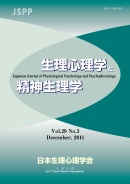All issues

Volume 19 (2001)
- Issue 3 Pages 89-
- Issue 2 Pages 35-
- Issue 1 Pages 1-
Volume 19, Issue 1
Displaying 1-4 of 4 articles from this issue
- |<
- <
- 1
- >
- >|
-
Katuo YAMAZAKI, Toshihiko OKAMURA, Noriyoshi TAKASAWA2001Volume 19Issue 1 Pages 1-6
Published: April 30, 2001
Released on J-STAGE: November 27, 2012
JOURNAL FREE ACCESSWe simultaneously recorded palmar sweating and skin potential responses (SPRs) to determine their relationship. We used a highly sensitive capacitance hygrometer to simultaneously record sweating responses from the palm and SPR by DC. Ten healthy male college students were enrolled as subjects. Stimuli such as continuous short tone burst and hand claps were randomly provided to induce sweating responses and SPR. When a total of 202 SPR waves induced were investigated in relation to sweating responses, sweating responses were observed in all 140 responses in which positive components were included in the SPR waves. However, no sweating responses were observed in 62 responses in which the SPR waves exhibited monophasic negative waves. These results suggest a close relationship between the positive components in SPRs and surface sweating. Our findings have presented a clear answer to the controversy surrounding this problem, and have partially verified Edelberg's poral valve model.View full abstractDownload PDF (917K) -
Kosuke KAIDA, Hiroshi NITTONO, Mitsuo HAYASHI, Tadao HORI2001Volume 19Issue 1 Pages 7-14
Published: April 30, 2001
Released on J-STAGE: November 27, 2012
JOURNAL FREE ACCESSA short nap is effective to prevent the afternoon arousal reduction (i.e., post lunch dip). However, sleep inertia remains just after awakening from nap. This study examined whether the self-awakening prevent sleep inertiaafter short nap. 10 healthy graduated students participated in the study. They took a nap from 14 : 00 for around 15 min in the self-awakening condition or for 20min in the forcedawakening condition from lights off. A 5-min session consisting of auditory oddball task (4min) and Visual analog scale (VAS : lmin) was carried out continuously twice (10min) before and six times (30min) after the nap. P300 amplitude of the event related potential was used to evaluate arousal levels. The VAS was used to evaluate feeling of sleepiness. P300 amplitudes during postnap sessions reduced significantly in the forcedawakening condition, while such reduction was not observed in the self-awakening condition. These results indicated that the arousal level after the nap was lower in the forced-awakening than the self-awakening condition. For the VAS scores, a feeling of sleepiness was improved after the nap. Especially, the improvement was greater in the self-awakening than forced-awakening condition. These results suggest that self-awakening was effective to reduce a post nap sleep inertia.View full abstractDownload PDF (1185K) -
Mizuki NAKAO, Makoto MIYATANI2001Volume 19Issue 1 Pages 15-23
Published: April 30, 2001
Released on J-STAGE: November 27, 2012
JOURNAL FREE ACCESSEvent-related brain potentials (ERPs) were recorded to investigate the sensitivity of N400 to attentional focusing on a specific representation in lexicon. Twelve subjects were required to detect a nonword preceded by a specific word in a series of successively presented words and nonwords. In this task, subjects intentionally kept attention to the particular word until that word was presented. According to two-process theories of attention (for example, Posner & Snyder, 1975), controlled attention to a specific word results in activation of the corresponding representation in lexicon, which is accompanied by inhibition of other representations. If the amplitude of N400 would reflect the activation level in lexicon, the N400 attenuation based on the semantic relation between two successive words would not be observed when subjects attend to a specific word, and the activation is limited to that word. The result, however, did not support this prediction. The N400 was smaller when the stimulus was preceded by a semantically related word than when preceded by an unrelated word, although N400 attenuation was small compared to when subjects' attention was not focused on any words. These suggested that N400 was more sensitive to the semantic integration of the word into the preceding context than to the attentional focusing in lexicon.View full abstractDownload PDF (1377K) -
Eiichi OGAWA2001Volume 19Issue 1 Pages 25-31
Published: April 30, 2001
Released on J-STAGE: November 27, 2012
JOURNAL FREE ACCESSReports the results of studies that investigated the relationship between loudness, reading speed, preference of material, type A behavior pattern and the cardiovascular reactivity (CVR). The present investigation addressed this issue by asking 15 type A (mean=20.5 years old) and l 6 type B subects (mean=21.5 years old) to read (1) subvocally in self=paced, (2) subvocally in stressed speed, (3) aloud in self-paced and (4) aloud in stressed speed. Subjects chose reading materials both they like and dislike. Systolic blood pressure (SBP), diastolic blood pressure (DBP) and heart rate (HR) were measured noninvasively using JENTOW-7700 every 5 s. Results indicated that SBP and HR response to reading aloud showed a significant rise from reading subvocally. Speed stress produced larger response than self=paced condition in SBP and DBP. Type A subjects showed larger HR in disliked reading task than liked one when reading aloud. In contras, type B subjects showed larger HR in disliked reading task than liked one when reading subvocally. These findings are discussed in light of earlier studies conceming physical and mental stress reactivity on cardiovascular system.View full abstractDownload PDF (749K)
- |<
- <
- 1
- >
- >|